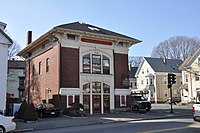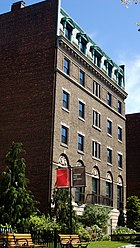



Kilham & Hopkins was an architectural firm in Boston, Massachusetts formed in 1899 or 1900 by its founding members, Walter Harrington Kilham (August 30, 1868 – September 11, 1948) and James Cleveland Hopkins (December 25, 1873 – 1938). The firm later became Kilham, Hopkins & Greeley after William Roger Greeley (May 12, 1881 – October 1966) joined the firm in 1916, and Kilham Hopkins Greeley and Brodie after Walter S. (Steve) Brodie (October 26, 1911 – January 1985) joined the firm in 1945.
The firm has been recognized for its contributions to early 20th century reform housing, including its work at the Atlantic Heights Development in Portsmouth, New Hampshire, at the Woodbourne Historic District in the Forest Hills section of the Jamaica Plain neighborhood of Boston, and for the Naumkeag Steam Cotton Company in the Salem Point Neighborhood of Salem, Massachusetts. A number of the firm's works, including Blithewold and Hose House No. 2, have been listed on the National Register of Historic Places.
History and membership
Kilham & Hopkins was formed in 1899 or 1900 by its founding members, Walter H. Kilham and James C. Hopkins. Both were graduates of Massachusetts Institute of Technology, Kilham receiving a B.S. in 1889 and Hopkins receiving his in 1895.
The works of the firm up to 1912 were documented in an illustrated retrospective, "The Work of Kilham & Hopkin: Architects of Boston, Massachusetts" published in Architectural Record. Kilham served as an instructor in architecture at the Massachusetts Institute of Technology for several years, and also developed a reputation for his work as a painter.
The firm became Kilham, Hopkins & Greeley after William Roger Greeley joined the firm in 1916. Greeley lived in Lexington, Massachusetts, wrote "The Essence of Architecture" in 1927, and served as moderator of the American Unitarian Association, the highest lay position in the Unitarian Church. The firm later became Kilham Hopkins Greeley and Brodie while Walter S. Brodie was a member of the firm from 1945 to 1970. One of the founder's sons, James C. Hopkins Jr. (c. 1914–1998), also became partner.
Firm founder Walter Kilham was an advocate for the end of tenement housing and for the construction of suitable housing for working men. By 1918, the firm "had achieved a reputation as advocates of housing reform and progressive town planning." The firm produced plans for World War I shipyard workers' Atlantic Heights Development in Portsmouth, New Hampshire, based upon their work in five projects already completed by the firm in Massachusetts. The firm's contributions to early 20th century reform housing were the subject of a 1987 work published by the University of Chicago Press.
In 1946, firm founder Walter Kilham published a book on the history of architecture in Boston.
A number of these architects' works are listed on the U.S. National Register of Historic Places.
Selected works
Works with varying attribution, include but are not limited to:
Kilham & Hopkins
- Aldworth Manor, also known as Aldworth Farm (Harrisville, NH) Alterations to Home and new Carriage House. Built for Arthur Childs. Listed in NRHP and cited in the 1916 publication of Current Architecture (Boston Architectural Club)
- One or more works in Atlantic Heights Development, Concord, Crescent, Falkland, Kearsarge, Porpoise, Preble, Raleigh and Saratoga Ways, Portsmouth, New Hampshire (Kilham & Hopkins), NRHP-listed
- Blithewold, built for William McKee, Ferry Road, Bristol, Rhode Island (Kilham & Hopkins), NRHP-listed
- Dr. J. L. Bremer House, Cohasset, Massachusetts (Kilham & Hopkins)
- Briggs Residence, Brookline, Massachusetts (Kilham & Hopkins)
- 132 Carlton St. Brookline, MA (designed in 1908 in the French Beaux Arts-style)
- Michael Driscoll School, aka Westbourne Terrace School, 64 Westbourne Terrace, Brookline, Massachusetts (Kilham & Hopkins)
- Edward Devotion School (1913), 345 Harvard Street, Brookline, Massachusetts (Kilham & Hopkins)
- J. H. Duer House, Brookline, Massachusetts (Kilham & Hopkins)
- Lockey House (1912), 93 Seaver St., Brookline, Massachusetts (Kilham & Hopkins)
- President Finley's Bungalow, Tanworth, New Hampshire (Kilham & Hopkins)
- First Congregational Church of Hyde Park, built 1910, 6 Webster St., Hyde Park, Boston, Massachusetts (Kilham & Hopkins), NRHP-listed
- Estate of W. Scott Fitz, Manchester-by-the-Sea, Massachusetts (Kilham & Hopkins)
- Franklin School, 7 Stedman Road, Lexington, Massachusetts (Kilham, Hopkins & Greeley), NRHP-listed
- Haverhill High School (former), Haverhill, Massachusetts (Kilham & Hopkins)
- Hopewell School, Monroe St., Taunton, Massachusetts (Kilham & Hopkins), NRHP-listed
- James C. Hopkins Residence, Dover, Massachusetts (Kilham & Hopkins)
- Hose House No. 2, 30 Rantoul St., Beverly, Massachusetts (Kilham & Hopkins), NRHP-listed
- Massachusetts Institute of Technology, Summer School of Engineering (aka "Camp Technology"), Gardner Lake, near East Machias, Maine (Kilham & Hopkins)
- William L. McKee Residence, Boston, Massachusetts (Kilham & Hopkins)
- Charles F. Painter House, 78 Farlow Road, Newton, Massachusetts (Kilham & Hopkins)
- B. F. Pitman House, Brookline, Massachusetts (Kilham & Hopkins)
- Old Salem High School (1909), 29 Highland Avenue at Jackson Street, Salem, Massachusetts (Kilham & Hopkins)
- Salem Point Neighborhood, six wood-frame, multi-family dwellings built in 1915 for employees of the Naumkeag Steam Cotton Company, 1 Prince Street Place, 2 Prince Street Place, and Dow Street, Salem, Massachusetts
- Charles P. Searle House, Ipswich, Massachusetts (Kilham & Hopkins)
- The Shurtleff School (1909), Chelsea, Massachusetts (Kilham & Hopkins)
- Simplex Electrical Co. (two concrete factories), Sydney Street, Cambridge, Massachusetts (Kilham & Hopkins)
- R. A. Stewart House, Brookline, Massachusetts (Kilham & Hopkins)
- Students House, 96 The Fenway, Boston, Massachusetts (Kilham, Walter H.; Hopkins, James C.), NRHP-listed
- Tewksbury Town Hall (1920), Tewksbury, Massachusetts (Kilham, Hopkins & Greeley)
- Unitarian Universalist Church of Marblehead (1911), Marblehead, Massachusetts (Kilham & Hopkins)
- Vose Grammar School (built 1909, demolished 2007), Central Avenue & Brook Road, Milton, Massachusetts (Kilham & Hopkins)
- C. N. Wallace House, Boston, Massachusetts (Kilham & Hopkins)
- Williams School (1909), Chelsea, Massachusetts (Kilham & Hopkins)
- Woodbourne Historic District (1911–1912), aka Forest Hills Cottages, Kilham & Hopkins developed the overall housing project of Woodbourne and designed numerous cottages, Forest Hills section of Jamaica Plain, a neighborhood of Boston, Massachusetts (Kilham & Hopkins), NRHP-listed
Kilham, Hopkins & Greeley
- Modifications to Lexington Depot (1921–22), Lexington, Massachusetts
- Brookline High School (c.1930), 141 Goddard Avenue, Brookline, Massachusetts (Kilham, Hopkins & Greeley)
- Cary Memorial Hall (1927), aka Isaac Harris Cary Memorial Building, 1605 Massachusetts Avenue, Lexington, Massachusetts (Kilham, Hopkins & Greeley, with Willard D. Brown)
- Community Sailing Boat House (1940/1941), Boston, Massachusetts (Kilham, Hopkins & Greeley)
- Marshfield High School (1940), Marshfield, Massachusetts (Kilham, Hopkins & Greeley)
- Waltham City Hall, Waltham, Massachusetts (Kilham, Hopkins & Greeley)
Kilham, Hopkins, Greeley & Brodie
- Amesbury High School (1969), 5 Highland St., Amesbury, Massachusetts (Kilham, Hopkins, Greeley & Brodie)
- Braintree Public Library (1954), Braintree, Massachusetts (Kilham, Hopkins, Greeley & Brodie)
- Dedham Town Hall and Office Building (1962), Dedham, Massachusetts(Kilham, Hopkins, Greeley & Brodie)
- The Governor's Academy (formerly Governor Dummer Academy): Moseley Chapel (1964) and Thompson Arts Center (1965), Byfield, Massachusetts (Kilham, Hopkins, Greeley & Brodie)
- Hamilton-Wenham Regional High School (1963), South Hamilton, Massachusetts (Kilham, Hopkins, Greeley & Brodie)
- Happy Hollow Elementary School (1954), Wayland, Massachusetts (Kilham, Hopkins, Greeley & Brodie)
- North Middlesex Regional High School (1961), Townsend, Massachusetts (Kilham, Hopkins, Greeley & Brodie)
Other
- Glover School (built 1916, demolished 2012), Maple Street, Marblehead, Massachusetts (Walter S. Brodie)
- Hingham Memorial Tower (1907), Hingham, Massachusetts (William Roger Greeley)
See also
- New Hampshire Historical Marker No. 286: The Atlantic Heights Neighborhood
References
- "Draft Registration Card for James Cleveland Hopkins, architect, born December 25, 1873". ancestry.com. September 12, 1918.
- "The AIA Historical Directory of American Architects: James C. Hopkins". American Institute of Architects. Archived from the original on 2013-11-11.
- ^ Lisa Mausolf (April 2006). "National Register of Historic Places Inventory/Nomination: Atlantic Heights Development". National Park Service. and accompanying photos
- ^ "Walter H. Kilham: Noted Architect, Author Built Shipyard Housing". Daily Boston Globe. September 12, 1948. p. C47. Archived from the original on February 1, 2013.
- ^ Robert Peabody Bellows. "Walter Harrington Kilham". Proceedings of the Massachusetts Historical Society. JSTOR 25080429.
- ^ Herbert Croly (February 1912). "The Work of Kilham & Hopkin: Architects of Boston, Massachusetts". Architectural Record. pp. 97–128.
- "Exhibition of Pictures by Walter H. Kilham". Daily Boston Globe. September 2, 1933. p. 17. Archived from the original on January 31, 2013.
- ^ American Architects Directory (PDF). 1962. p. 263. Archived from the original (PDF) on 2012-04-23. Retrieved 2012-09-26.
- William Roger Greeley (1927). The Essence of Architecture. D. Van Nostrand Company.
- "Unitarians Name Lexington Man". The Christian Science Monitor. August 22, 1953. Archived from the original on January 31, 2013.
- "Obituary: W. R. Greeley, Architect, Civic Planner". Boston Globe. October 11, 1966. Archived from the original on February 1, 2013.
- "A Man for All Season". Boston Globe. October 11, 1966. Archived from the original on January 31, 2013.
- "Walter S. Brodie, 73; Architect, Designed Schools in Mass., Maine". Boston Globe. January 23, 1985. Archived from the original on January 31, 2013.
- ^ American Architects Directory (PDF). American Institute of Architects. 1970. p. 105. Archived from the original (PDF) on 2012-03-31.
- "James C. Hopkins, 84, Partner in architectural firm". Boston Globe. October 31, 1998.
- "New Era Seen In Housing for Workingmen: Boston Architect in Address Before the Cambridge Board of Trade Says There Are Signs of End to Tenement Flats". The Christian Science Monitor. February 24, 1916. p. 4. Archived from the original on February 1, 2013.
- Richard M. Candee; Greer Hardwicke (1987). "Early Twentieth Century Reform Housing by Kilham & Hopkins, Architects of Boston". Winterthur Portfolio. 22 (1). University of Chicago Press: 47–80. doi:10.1086/496311. JSTOR 1181147. S2CID 159953152.
- William Germain Dooley (September 1, 1946). "Review of "Boston After Bullfinch: An Account of Its Architecture, 1800-1900," by Walter H. Kilham". The New York Times.
- ^ "National Register Information System". National Register of Historic Places. National Park Service. July 9, 2010.
- ^ "132 Carlton St, Brookline, MA". Zillow.
- ^ Aymar Embury (1909). One Hundred Country Houses: Modern American Examples. The Century Co. pp. 22–26.
pitman house brookline.
- Massachusetts Cultural Resource Information System
- Massachusetts MPS Fisher Hill Historic District, National Register of Historic Places and National Historic Landmarks Program
- ^ "Three Massachusetts School Houses, Kilham & Hopkins, Architects". The Brickbuilder. December 1909. pp. 243–246.
- Bryant F. Tolles Jr. (2004). Architecture in Salem: An Illustrated Guide. UPNE. p. 275. ISBN 158465385X.
- "Massachusetts Historical Commission Area form for Salem Point Neighborhood" (PDF). Vanasse Hangen Brustlin, Inc. June 2006. pp. 5–6 of 39. Archived from the original (PDF) on 2008-08-30.
- "American Seaside Homes". Journal of the RoyalInstitute of British Architects, Volumes 27-28. 1910. pp. 109–111.
- "DEDICATE CHELSEA'S FINEST NEW SCHOOL STRUCTURE TONIGHT". Christian Science Monitor. December 16, 1909. Archived from the original on January 31, 2013.
- "Unitarian Universalist Church of Marblehead (1911)". Historic Buildings of Massachusetts.
- "Vose School / High School". Milton Historical Society. Archived from the original on 2011-12-17.
- Greer Hardwicke, Preservation Consultant, and Betsy Friedberg, Massachusetts Historical Commission (April 1999). "Woodbourne Historic District". Jamaica Plain Historical Society.
{{cite web}}: CS1 maint: multiple names: authors list (link) - Yearby, Jean P. (1984). "Photographs: Historical and Descriptive Data: MA-21 Lexington & West Cambridge Railroad Lexington Depot" (PDF). Historic American Engineering Record. National Park Service.
- Fisher Hill, Tour One, Brookline Preservation Commission
- "Lexington Comprehensive Cultural Resources Survey: Cary Memorial Hall" (PDF). Massachusetts Historical Commission. August 1, 1978. Archived from the original (PDF) on March 3, 2016. Retrieved September 26, 2012.
- Mills Whitaker Architects. "Contract no. 10-55: Final Report, Isaac Harris Cary Memorial Building Evaluation" (PDF). City of Lexington.
- "Appendix B, History" (PDF). State of Massachusetts, Department of Conservation and Recreation. p. 174.
- "Construction begins on Glover School in Marblehead". Boston Globe. August 15, 2012.